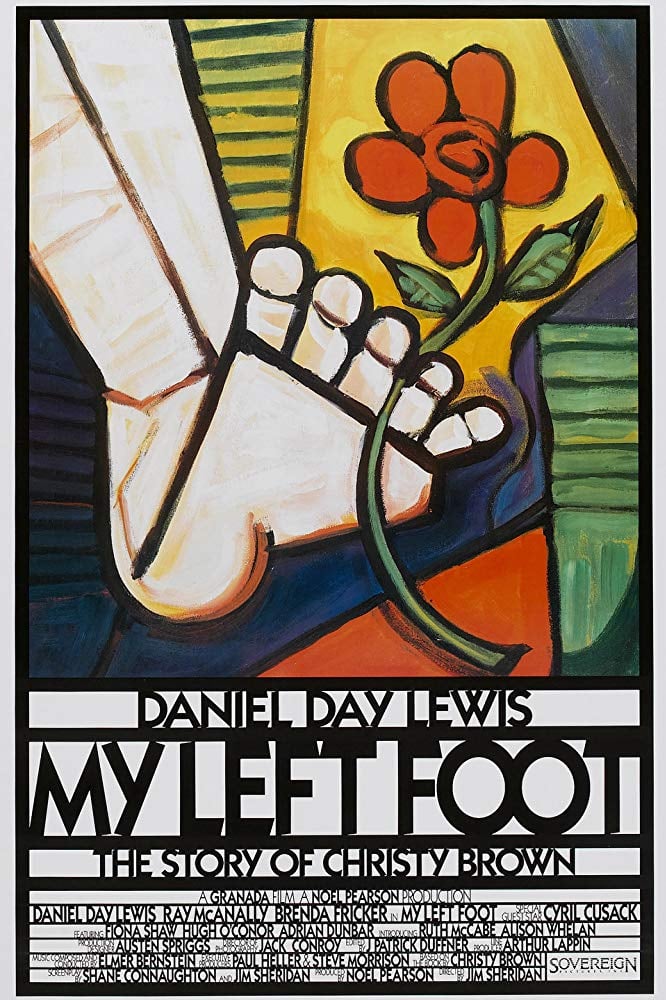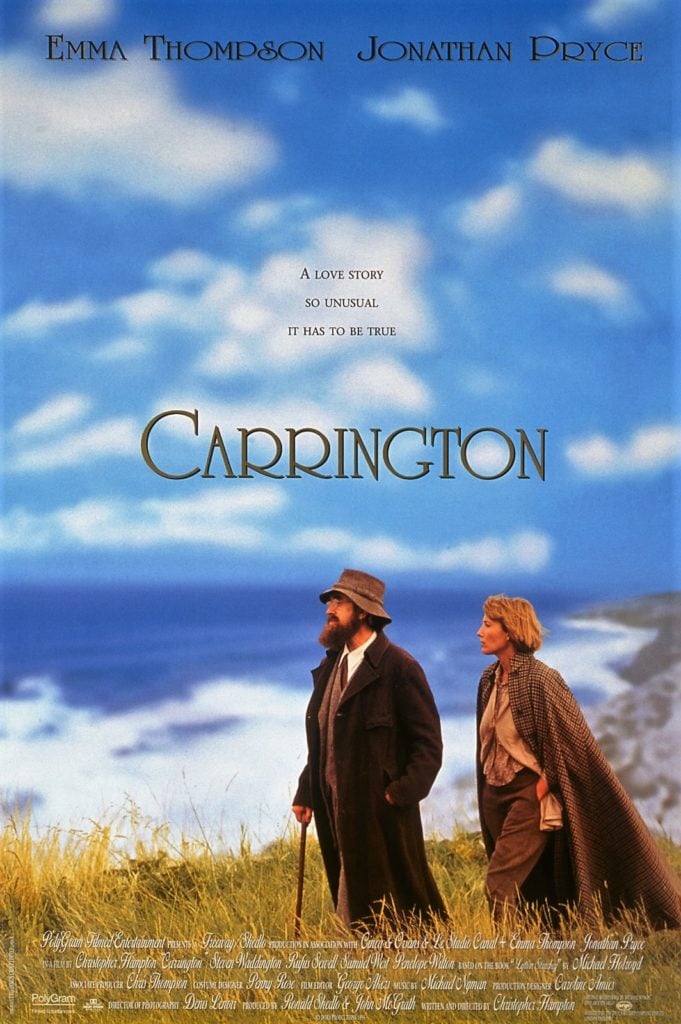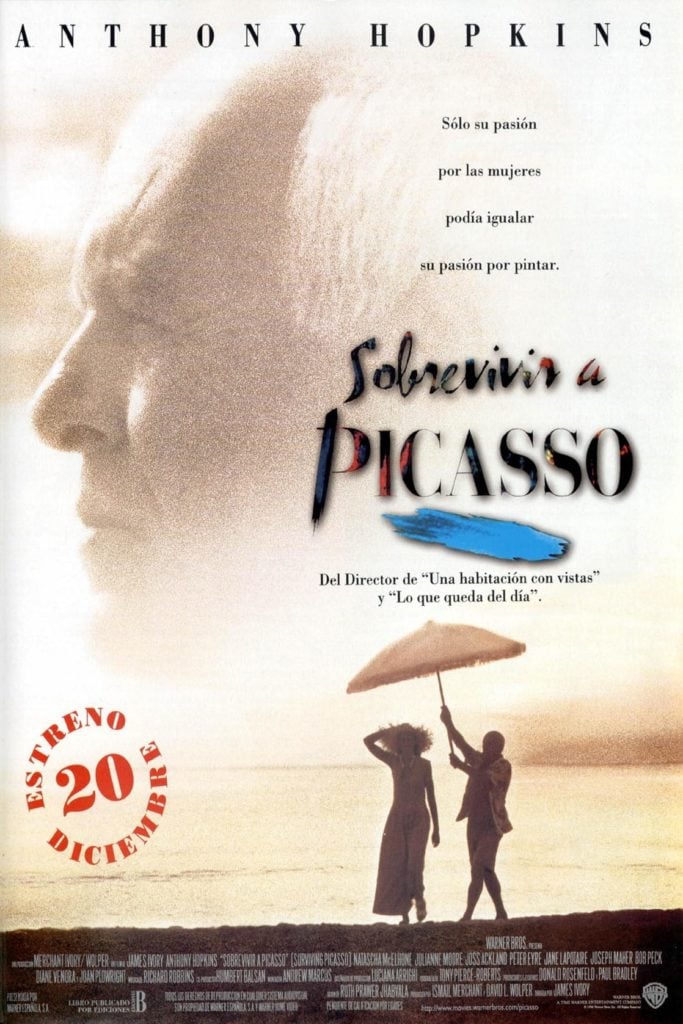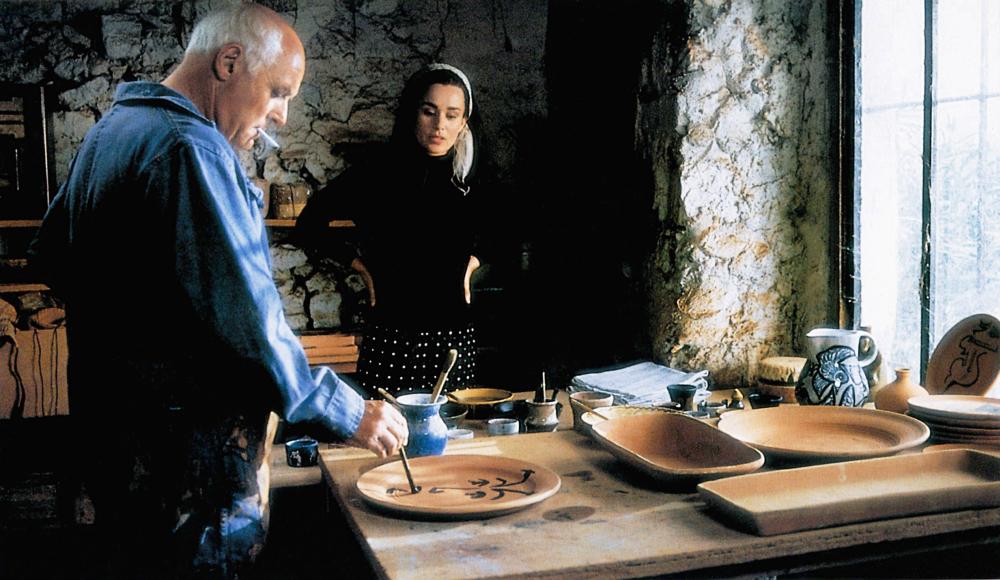What makes for a successful artist biopic? These days, the proliferation of these movies streaming out of Hollywood are mostly united by a focus on larger-than-life creative celebrity (the upcoming Leonardo starring Leonardo) or are excuses for art-inspired fantasy (Robert Zemeckis’s critically panned, CGI-driven take on outsider artist Mark Hogencamp, Marwen). But that has not always been the case.
Kitchen-sink realism, costume drama, and a love of eccentric character were the major pillars of British cinema going into its 1990s boom. When it came to the kind of artists who got the biopic treatment, the emphasis on human interest resulted in some unexpected artists finding their way onto the screen.
Such is the case with the figures at the heart of both My Left Foot (Christy Brown) and Carrington (Dora Carrington). Even the Merchant/Ivory production Surviving Picasso, whose subject is about as famous as you can get, unexpectedly proves to be more about aspiring painter Françoise Gilot than about the man himself—though I am not going to pretend that most of its fun doesn’t lie in seeing how familiar bits of Picasso lore are staged. It definitely does.
(This is the fifth part of a seres on artist biopics. The previous parts are here, here, here, and here.)

Poster for My Left Foot (1989).
What It Is: Jim Sheridan’s My Left Foot has a reputation as an eat-your-vegetables movie. The British-Irish co-production regularly makes lists of both greatest British films and greatest Irish films, and owes its substantial fame to Daniel Day-Lewis’s wrenchingly humane performance as a man born with cerebral palsy. Barely able to speak or move, the protagonist is only able to use his foot to hold a paintbrush or work a typewriter (or sometimes, to do some righteous pub brawling), eventually becoming accomplished as both painter and writer.
But the film is also an appealingly earnest take on a famous artistic figure: the full title is actually My Left Foot: The Story of Christy Brown, and Brown was very much well-known for his art in Dublin and beyond. The film is framed by scenes of Brown being celebrated at a gala, cutting back to his upbringing in between to tell his story. It is the stubborn sense of the realness of this real-life creative legend—there are no flights of visual fancy or recourses to the poetry of an interior monologue—that gives the whole thing its satisfyingly delicate sense of hard-earned triumph.
The framing story implies a happy ending, with Brown capping his valedictory gala appearance by offering his love to his nurse Mary Carr (Ruth McCabe). I gather the actual relationship was a lot more complicated and dark, descending into alcoholism, isolation, and possible abuse, a sadder conclusion that was given its due as a chapter in Brown’s story by an exhibition that toured from Dublin’s Little Museum in 2015.
What It Contributes to the Genre: My Left Foot is a movie about someone who is isolated by his physical condition—but Brown’s art, as it is shown, is focused on neither the interior nor the imagination. In fact, the film’s vision of art’s function and value is fiercely social.
At the mid-point, you see a gallery show of his moody paintings depicting friends and family. “If you look around the walls today, you’ll see the forces that shape Christy Brown,” his dealer declares.
A few scenes earlier, a teenage Brown is making art to express a crush on a girl in the neighborhood. Before that, the most basic, first successful creative act of the young Brown (Hugh O’Conor)—the symbolic gesture that all the others are shown to grow out of—is scratching out the word “MOTHER” on the floor in chalk, to prove that he’s mentally present and connected to the family, even if he cannot move most of his body.
As an artist movie, what My Left Foot really offers almost better than any other I can think of is this sense of art as a form not just of individual self-expression, but as a vehicle of necessary, sustaining communication.

Poster for Carrington (1995).
What It Is: Carrington, aka Dora Carrington (she preferred to go by just the one name), was a British painter in the Bloomsbury Group orbit, but not one whose work was particularly known in her lifetime. Instead, she was known as a character: for her bohemian lifestyle and for her scandalous relationship with the author Lytton Strachey, or, as Louisa Buck once put it, for “a radical haircut and a notoriously complicated love life.”
Christopher Hampton’s film is not really interested in reconsidering the proportion of interest given to Carrington’s life over her art. The focus is squarely on the artist as a colorful character (she’s played by Emma Thompson, who’s great—though better at capturing Carrington’s neuroses than her brazen side). She navigates a confusing series of relationships with men who are various flavors of bozo, but always returns to her passionate attachment to Strachey (Christopher Price, also great), who treats her as a life partner but prefers men in bed.
To be fair, this depiction seems to somewhat reflect the artist’s actual assessment of her own talents (“It’s rather maddening,” real-world Carrington once said, “to have the ambition of Tintoretto and to paint like a diseased dormouse”). Here, Carrington’s paintings just sort of hang around in the background of the film, uncommented upon—in particular her 1916 portrait of Strachey reading, his long, elegant hands painted with lightly mannerist exaggeration.
She’s shown distracting herself at the easel, but when Strachey asks her why she doesn’t show more, she shrugs it off with the equivalent of “why bother?”
There’s one truly memorable scene in the film, where Thompson’s Carrington sits outside of a manor house, alone in the dark looking up through the windows, each framing a different man in her life getting ready for bed with their various lovers, men or women, as if puzzling over her place in it all. But it doesn’t have anything to do with Carrington’s art—unless you want to take it as a metaphor for a social status that made it so her artistic voice didn’t seem to have a place, not even to her.
What It Contributes: The film is a nice, if over-genteel, depiction of the foibles of a polyamorous lifestyle. It’s fair to say that “art,” as a space in the imagination and a real-world milieu, takes part of its allure from being a space open to experimental lifestyle arrangements.
Worth noting, though: Despite its hip-for-the-‘90s openness about the gay relationships among its male characters, Carrington gives not a hint of its protagonist’s desire for women. These included a passionate affair with American heiress Henrietta Bingham, whom Carrington made art about at least twice, in the painting Reclining Nude With Dove in a Mountainous Landscape and in the brazen nude Drawing of Henrietta Bingham in Heels.

Poster for Surviving Picasso (1996).
What It Is: The much-respected producer-director team Merchant & Ivory previously deployed Anthony Hopkins in Howards End and Remains of the Day. But where those spun very British drawing-room tales into Oscar bait, this film has them slowly, very slowly letting the air out of the Picasso legend—with all of the flatulent atmosphere that that might imply.
I mean, you can see what they are thinking: Anthony Hopkins, great actor; Anthony Hopkins, can be made to look like Picasso if you squint; Anthony Hopkins, at 59, about the perfect age for this story, which tackles the aging Picasso’s postwar sexcapades through the eyes of restive muse Françoise Gilot (a 27-year-old Natascha McElhone; the real Gilot was 22 when she met Picasso).
The best bits of the film are extraneous to the central relationship drama. There’s Picasso behaving like a diva, forcing his crass American dealer Kurt Koontz (Dennis Boutsikaris) to degrade himself to get access to his latest work. Picasso makes the dealer give him his tie, then tells him to come back tomorrow.
And there’s Picasso being honored after the war by the Communists, attending a Party conference in Poland and getting a medal but having to defend himself from the charge of petit-bourgeois “anarchy.” A Russian critic drunkenly denounces his “Impressionist-Surrealist style.” Picasso replies, “Comrade, if you must insult me, at least get your terminology straight.”
At a certain point, the Spanish artist’s cruelty towards women is illustrated in flashback by having him tell rival lovers Marie-Thérèse Walter and Dora Maar to battle for him, as he stands with his back to them, painting Guernica.
Julianne Moore, incidentally, is the bright spark of the movie as Maar—though she has a really odd accent, and the film doesn’t give her any real depth of character outside her function of haunting the edges of the plot as a woman ruined by Picasso. The actual Maar was a cool Surrealist photographer and the one who actually convinced Picasso to join the French Communist Party.
What It Contributes: Surviving Picasso was roughly inspired by Gilot’s memoirs, which is why it centers on Gilot. But both Gilot and the Picasso estate hated the idea—Gilot called the film “idiotic”—which is why the Picasso paintings in the film are mainly odd pastiches. (Instead, it is officially based on Arianna Huffington’s Picasso, Creator and Destroyer.)
Hopkins never captures Picasso’s intensity—creative or carnal—or his sadism. When he says, showing Gilot and her friend his studio, “You two are now in the labyrinth of the Minotaur. And the Minotaur must devour two maidens a day to survive,” he sounds like an Oxbridge literature professor who’s just read The Game; it’s neither enticing nor sinister.
McElhone is a block of wood as Gilot, so the celebration of her strength and creative self-actualization doesn’t land. And Ivory’s direction is so sanitary that none of the necessary torment or psychodrama registers.
It must be said nevertheless: Telling the Picasso story from the point of view of the women in his life, and taking apart his sex god legend, is a great and even important idea for a movie. Surviving Picasso is just not the movie that the idea deserves.
Follow Artnet News on Facebook:
Want to stay ahead of the art world? Subscribe to our newsletter to get the breaking news, eye-opening interviews, and incisive critical takes that drive the conversation forward.









